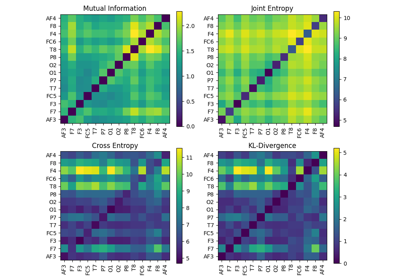spkit.mutual_info¶
- spkit.mutual_info(x, y, base=2, is_discrete=False, bins='fd', return_n_bins=False, verbose=False, ignoreZero=False)¶
Mututal Information \(I(X;Y)\)
\[I(X;Y) = H(X)+H(Y)-H(X,Y)\]\[I(X;Y) = H(X) - H(X|Y)\]\[0 <= I(X;Y) <= min\{ H(x), H(y)\}\]- Parameters:
- x,y1d-arrays
- is_discrete: bool, default=False.
If True, frequency of unique values are used to estimate I(x,y)
- base: base of log,
decides the unit of entropy
if base=2 (default) unit of entropy is in bits, base=e, nats, base=10, bans
- bins: {str, int, [int, int]}.
str decides the method of compute bin-width, bins=’fd’ (default) is considered as optimal bin-width of a real-values signal/sequence.
check
bin_widthfor more Methodsif bins is an integer, then fixed number of bins are computed for both x, and y.
if bins is a list of 2 integer ([Nx, Ny]),then Nx and Ny are number of bins for x, and y respectively.
- return_n_bins: bool, (default=False)
if True, number of bins are also returned.
- ignoreZero: bool, default=False
if true, probabilities with zero value will be omited, before computations
It doesn’t make much of difference
- Returns:
- IMutual Information I(x,y)
- (Nx, Ny)tuple of 2
number of bins for x and y, respectively (only if return_n_bins=True)
See also
entropy_jointJoint Entropy
entropy_condConditional Entropy
entropy_kldKL-diversion Entropy
entropy_crossCross Entropy
Examples
>>> #sp.mutual_info >>> import numpy as np >>> import matplotlib.pyplot as plt >>> import spkit as sp >>> np.random.seed(1) >>> x = np.random.randn(1000) >>> y1 = 0.1*x + 0.9*np.random.randn(1000) >>> y2 = 0.9*x + 0.1*np.random.randn(1000) >>> I_xy1 = sp.mutual_info(x,y1) >>> I_xy2 = sp.mutual_info(x,y2) >>> print(r'I(x,y1) = ',I_xy1, '\t| y1 /= e x') >>> print(r'I(x,y2) = ',I_xy2, '\t| y2 ~ x') >>> np.random.seed(None) I(x,y1) = 0.29196123466326007 | y1 /= e x I(x,y2) = 2.6874431530714116 | y2 ~ x






